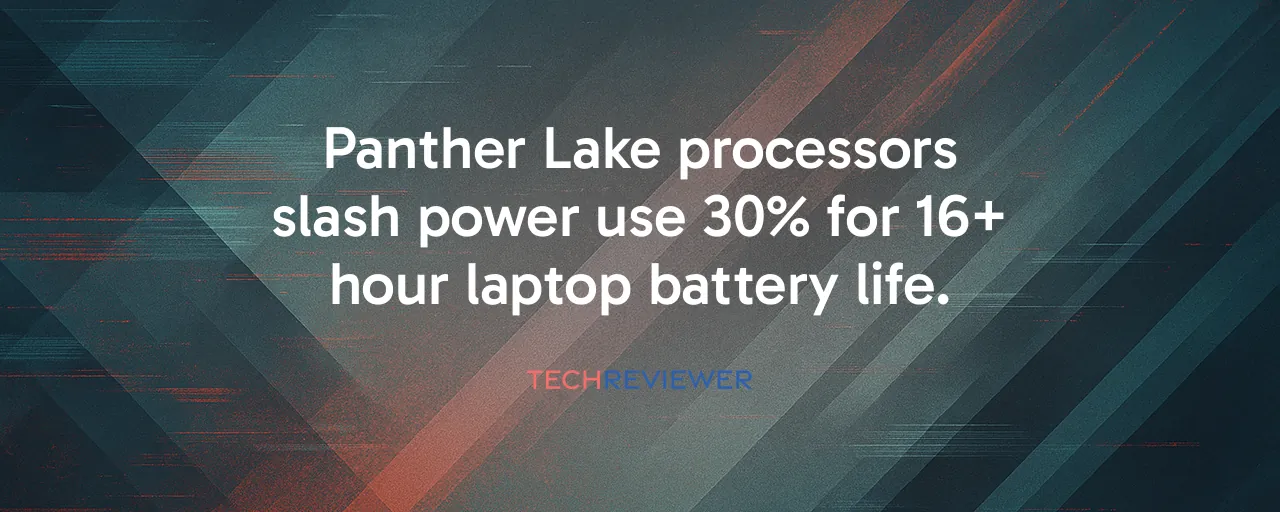A New Era for Laptop Performance
Intel's Panther Lake processors, set to hit premium laptops in early 2026, could shake up the mobile computing world. These chips, built on Intel's cutting-edge 18A process, deliver a 30 percent drop in power consumption compared to earlier models, alongside a 50 percent speed boost for specific tasks. For anyone who's ever scrambled to find a charger mid-workday, this could mean laptops that last well over 16 hours on a single charge. The stakes are high for Intel, which has been losing ground to AMD's Ryzen processors in recent years. With redesigned cores and graphics, Panther Lake aims to set a new standard for what laptops can do.
The timing feels critical. AMD now holds 20 percent of the mobile processor market, a sharp rise from its near-zero share a decade ago, while Intel's dominance has slipped from over 80 percent to just over 60 percent. Panther Lake represents Intel's boldest move yet to reclaim its edge, banking on innovations like RibbonFET transistors and PowerVia delivery to outshine competitors. But can Intel deliver on its promises, especially after years of manufacturing hiccups? The answer lies in how these chips perform in real-world devices.
Breaking Down the Tech Behind Panther Lake
What makes Panther Lake stand out? It starts with the 18A process, Intel's most advanced manufacturing tech yet. The chips use RibbonFET, a gate-all-around transistor design that wraps the gate around the channel for better control, cutting power use by 36 percent at matched performance levels compared to the Intel 3 process. Then there's PowerVia, a first-of-its-kind backside power delivery system that separates power and signal routing, slashing voltage droop by up to 10 times. Together, these advancements allow Panther Lake to pack more power into a smaller, more efficient package, with over 30 percent better density than its predecessors.
The chips themselves are a hybrid marvel, combining up to four performance cores, eight efficiency cores, and four low-power cores for background tasks. This three-tier setup lets laptops handle everything from light web browsing to heavy video editing without breaking a sweat. The Xe3 Celestial graphics, with up to 12 execution units, deliver a 15-30 percent boost in gaming performance over Lunar Lake's graphics. And for AI fans, the integrated neural processing unit (NPU) hits 180 TOPS, enough to run large language models locally, keeping your data off the cloud. The real test will be whether it translates to everyday use.
Real-World Wins: Lessons From Lenovo and Acer
To see what Panther Lake might deliver, look at Lenovo's Yoga Slim 7i Aura Edition, powered by Intel's Lunar Lake chips. It clocked nearly 24 hours of video playback, outlasting Apple's M2 and M3 MacBooks by over five hours in Lenovo's tests. This shows Intel can compete on battery life when everything clicks, a promising sign for Panther Lake's 30 percent power reduction. Meanwhile, Acer's Swift 16 AI, the first confirmed Panther Lake laptop, signals early confidence from manufacturers. Unveiled at IFA 2025, it hints at what's coming: sleek designs with all-day battery life and AI-driven features for professionals and creators.
These examples highlight a key lesson: efficiency now drives laptop sales more than raw power. Lenovo's success with Lunar Lake came from prioritizing battery life, a trend Panther Lake intensifies with. But Acer's early commitment also shows the risk. If Intel's yields falter, as they did with earlier nodes, manufacturers like Acer could face shortages, leading them to consider AMD's reliable Ryzen AI 300 series, which already offers 50 TOPS and 13-plus hours of battery life. The takeaway: Intel's tech is impressive, but execution is everything.
The Bigger Picture: Intel vs. the Competition
Intel isn't just fighting AMD. Apple's M-series chips, with their unmatched efficiency, and Qualcomm's Snapdragon X, boasting 18.5-hour battery life, are reshaping the laptop landscape. Panther Lake's 180 TOPS NPU outpaces Qualcomm's 45 TOPS, but Apple's M4 hits 50,889 TOPS in neural tasks while sipping power. Intel's edge lies in its x86 compatibility, letting it run decades of software without translation layers, unlike ARM-based chips. Still, AMD's Ryzen processors have closed the gap, with 32 percent desktop CPU share and 39 percent revenue share in Q2 2025, thanks to TSMC's manufacturing reliability.
Intel's response is pragmatic: Panther Lake uses TSMC's N3E process for graphics tiles while keeping CPU tiles on 18A. This approach leverages the strengths of both, but it also admits Intel's own fabs aren't fully ready for everything. If Panther Lake delivers, it could strengthen relationships with partners like Dell and HP, who plan 2026 launches. If it stumbles, AMD and Apple stand ready to capitalize, with Qualcomm waiting in the wings. The competition has never been fiercer, and Intel's future hinges on getting this right.
Challenges and What's at Stake
Panther Lake's biggest hurdle is manufacturing yield. At 55 percent in Q3 2025, Intel's 18A process is improving but lags TSMC's 65 percent for its N2 node. Intel needs 70 percent yields by year-end to make production profitable, a tight deadline given the complexity of RibbonFET and PowerVia. Low yields could mean higher prices or supply shortages, pushing laptop makers to AMD or Qualcomm. There's also the question of software. The 180 TOPS NPU delivers impressive power, but without apps that fully use it, it's just an impressive specification. Intel's betting on partnerships with Microsoft and developers to make AI features shine, but that ecosystem is still maturing.
Beyond tech, Panther Lake carries weight for U.S. manufacturing. With billions from the CHIPS Act, Intel's Arizona and Ohio fabs are part of a push to bring chipmaking home. Success could mean jobs and reduced reliance on TSMC, especially amid tensions over Taiwan. Failure might force Intel to lean harder on TSMC, reshaping its business model. For users, it's about better laptops: longer battery life, smoother performance, and AI that doesn't need the cloud. But with so much riding on Panther Lake, Intel has to nail the launch, or risk losing more ground in a cutthroat market.
